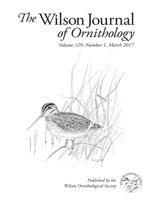Wild Amazonian parrots likely consume soil to supplement sodium-deficient diets. However, it remains uncertain whether parrots can detect sodium at the concentrations found in mineral licks. During 3–8 day trials, we presented 20 captive Hispaniolan Amazon Parrots (Amazona ventralis) two foods with experimentally manipulated sodium concentrations. Parrots consumed more of the lower sodium food, confirming that they could distinguish between 891 ppm and 1,644 ppm available sodium—values well within the range of concentrations found in mineral licks in the wild. This study strongly suggests that wild parrots can use taste to detect salty soil horizons in the Amazon.
How to translate text using browser tools
1 March 2017
Captive Hispaniolan Parrots (Amazona ventralis) can discriminate between experimental foods with sodium concentrations found in Amazonian mineral licks
Luke L. Powell,
Kelsy L. Jones,
Jonathan H. Carpenter,
Thomas N. Tully
ACCESS THE FULL ARTICLE





